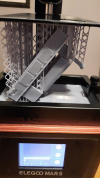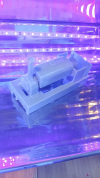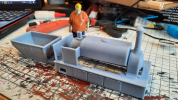The resin will stay liquid until exposed to UV light - including daylight. It is stored in solid bottles to prevent light getting in and the printer normally has a filter cover over the top.
It's recommended you don't leave the printer "loaded" for more than about 48 hours and that you regularly strain the resin to remove any bits of failed print or hardened material.
The print process relies on an image being projected onto the bottom of the resin tank - which is made of a transparent material - FEP. In the Mars printer, an LCD screen and UV light source is used, while the original SLA machines use a scanning laser. The build platform is brought to within about 50uM of the bottom of the tank and the first exposure - about 60 seconds takes place. This hardens the material to the build plate and the plate will then move up about 5mm, "peeling" the solidified resin off the bottom of the tank and (hopefully) leaving it attached to the build plate. The plate then descends again so that the layer is just above the bottom of the tank and the process repeated - albeit for 6-7 seconds for each layer.
Once all 1000 layers or so are printed, the finished article is brought fully out of the tank and allowed to drain for at least an hour. At this point, it is removed, the supports removed and the model washed in IPA to remove uncured resin. The print is then baked in a UV source to fully harden it. Alternatively, on a sunny day, just leave it in the sun for an hour or so!
SLA is the earliest type of 3D printing, first demonstrated in the early 80s with the first commercial printers going on sale in 1987. Early machines were "right side up" so you needed a vat of resin at least the height of the item you wanted to print. Home printers are normally inverted with the transparent tank system, which uses less resin, but can lead to failed prints due to the mechanical interface for each print layer. This is why you print at strange angles to reduce the peeling forces required on large surface areas.
Hope this helps!
If anyone wants any bits resin printing, happy to oblige for the cost of the materials. As an example, this loco body cost about £7 in materials and consumables to print.



